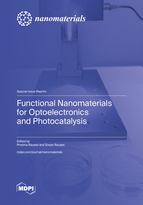Functional Nanomaterials for Optoelectronics and Photocatalysis
A special issue of Nanomaterials (ISSN 2079-4991). This special issue belongs to the section "Nanophotonics Materials and Devices".
Deadline for manuscript submissions: closed (31 May 2023) | Viewed by 25148
Special Issue Editors
Interests: nanoparticles; thin films; carbon-based hybrid materials; photovoltaics; LED; photocatalysis; electron microscopy; water purification
Special Issues, Collections and Topics in MDPI journals
Interests: metal-oxide thin-film deposition; atomic layer deposition; nanomaterial synthesis; metal nanoparticles; metal-oxide nanoparticles; water purification; nanomedicine; photovoltaics; hybrid nanocomposites
Special Issues, Collections and Topics in MDPI journals
Special Issue Information
Dear Colleagues,
Energy efficient devices are the need of the hour. In this regard, functional and energy efficient nanomaterials with high-end applications such as optoelectronic devices, which encompass diode lasers, light emitting diode (LED) and photovoltaics (PV), have gained much attention. In addition, semiconducting nanomaterials also find applications in photocatalysis. In such nanomaterials, surface states as well as quantum effects influence their optoelectronic as well as photocatalytic activities. Metal nanoparticles exhibiting surface plasmon resonance (SPR) such as Ag, Cu and Au, further enhance their properties. Nanomaterial-based devices present several advantages such as ease of fabrications and low cost. Moreover, conformal coating of nanomaterials on flexible substrates produce more versatile and lightweight devices.
This Special Issue invites all researchers in the field to submit relevant publications in optoelectronics and photocatalysis. These include organic, inorganic, and hybrid (organic-inorganic) nanomaterials. Additionally, publications that report on device fabrication using these nanomaterials are also actively sought.
Prof. Dr. Protima Rauwel
Prof. Dr. Erwan Rauwel
Guest Editors
Manuscript Submission Information
Manuscripts should be submitted online at www.mdpi.com by registering and logging in to this website. Once you are registered, click here to go to the submission form. Manuscripts can be submitted until the deadline. All submissions that pass pre-check are peer-reviewed. Accepted papers will be published continuously in the journal (as soon as accepted) and will be listed together on the special issue website. Research articles, review articles as well as short communications are invited. For planned papers, a title and short abstract (about 100 words) can be sent to the Editorial Office for announcement on this website.
Submitted manuscripts should not have been published previously, nor be under consideration for publication elsewhere (except conference proceedings papers). All manuscripts are thoroughly refereed through a single-blind peer-review process. A guide for authors and other relevant information for submission of manuscripts is available on the Instructions for Authors page. Nanomaterials is an international peer-reviewed open access semimonthly journal published by MDPI.
Please visit the Instructions for Authors page before submitting a manuscript. The Article Processing Charge (APC) for publication in this open access journal is 2900 CHF (Swiss Francs). Submitted papers should be well formatted and use good English. Authors may use MDPI's English editing service prior to publication or during author revisions.
Keywords
- thin films
- nanoparticles
- polymers
- hybrid nanomaterials
- carbon based nanomaterials
- quantum effect
- surface plasmon resonance
- photovoltaics
- laser diodes
- light emitting diodes
- photocatalysis and device fabrication








